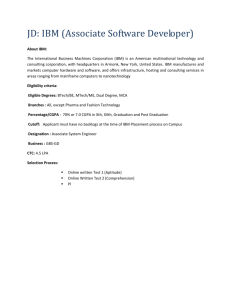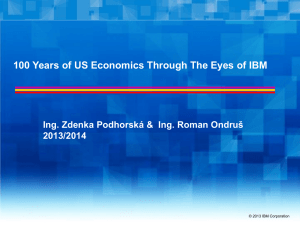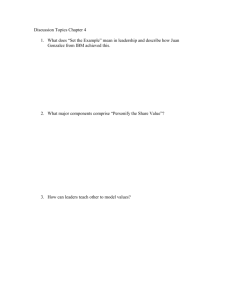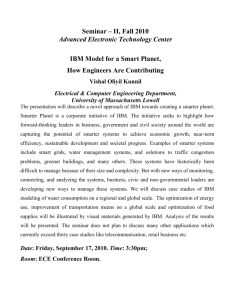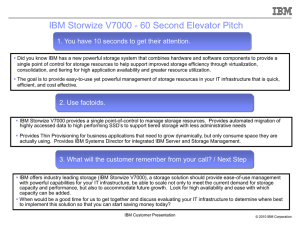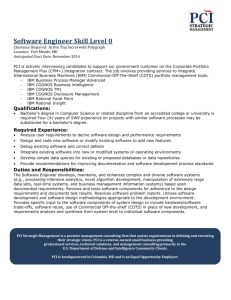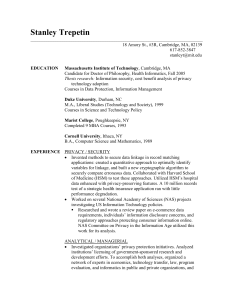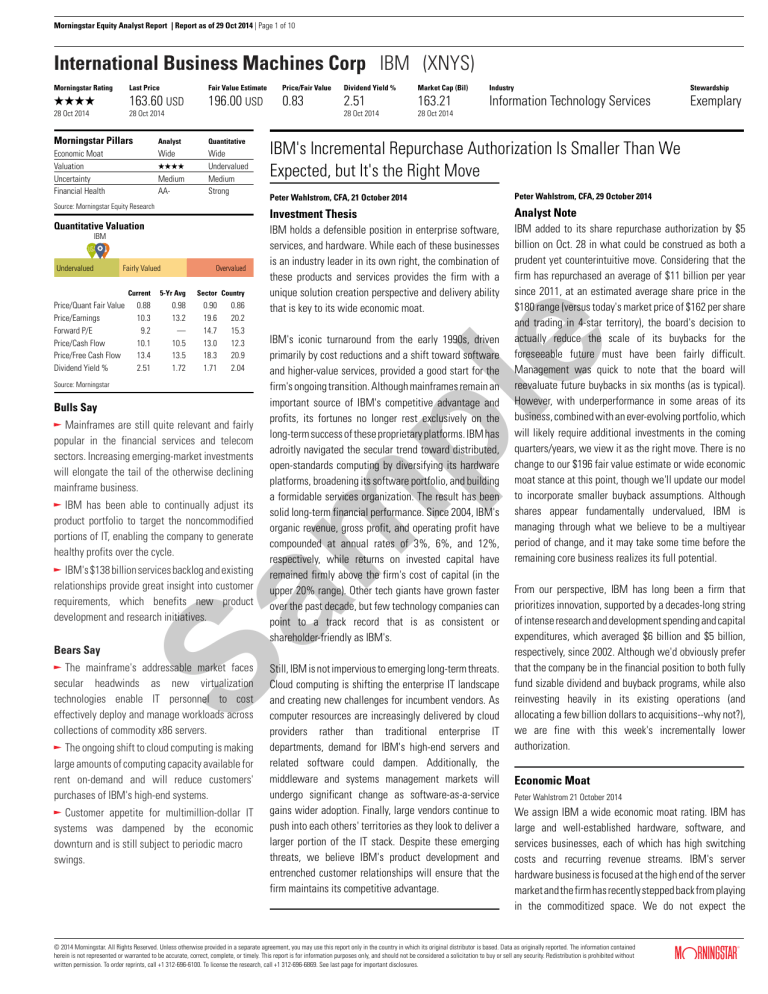
Morningstar Equity Analyst Report | Report as of 29 Oct 2014 | Page 1 of 10
International Business Machines Corp IBM (XNYS)
Morningstar Rating
Last Price
Fair Value Estimate
Price/Fair Value
Dividend Yield %
Market Cap (Bil)
Industry
Stewardship
QQQQ
163.60 USD
196.00 USD
0.83
2.51
163.21
Information Technology Services
Exemplary
28 Oct 2014
28 Oct 2014
28 Oct 2014
28 Oct 2014
Analyst
Quantitative
Economic Moat
Valuation
Uncertainty
Financial Health
Wide
QQQQ
Medium
AA-
Wide
Undervalued
Medium
Strong
Source: Morningstar Equity Research
Quantitative Valuation
IBM
USA a
Undervalued
Fairly Valued
Price/Quant Fair Value
Price/Earnings
Forward P/E
Price/Cash Flow
Price/Free Cash Flow
Dividend Yield %
Overvalued
Current
5-Yr Avg
0.88
10.3
9.2
10.1
13.4
2.51
0.98
13.2
—
10.5
13.5
1.72
Sector Country
0.90
19.6
14.7
13.0
18.3
1.71
0.86
20.2
15.3
12.3
20.9
2.04
Bulls Say
Peter Wahlstrom, CFA, 21 October 2014
Peter Wahlstrom, CFA, 29 October 2014
Investment Thesis
Analyst Note
IBM holds a defensible position in enterprise software,
services, and hardware. While each of these businesses
is an industry leader in its own right, the combination of
these products and services provides the firm with a
unique solution creation perspective and delivery ability
that is key to its wide economic moat.
IBM added to its share repurchase authorization by $5
billion on Oct. 28 in what could be construed as both a
prudent yet counterintuitive move. Considering that the
firm has repurchased an average of $11 billion per year
since 2011, at an estimated average share price in the
$180 range (versus today's market price of $162 per share
and trading in 4-star territory), the board's decision to
actually reduce the scale of its buybacks for the
foreseeable future must have been fairly difficult.
Management was quick to note that the board will
reevaluate future buybacks in six months (as is typical).
However, with underperformance in some areas of its
business, combined with an ever-evolving portfolio, which
will likely require additional investments in the coming
quarters/years, we view it as the right move. There is no
change to our $196 fair value estimate or wide economic
moat stance at this point, though we'll update our model
to incorporate smaller buyback assumptions. Although
shares appear fundamentally undervalued, IBM is
managing through what we believe to be a multiyear
period of change, and it may take some time before the
remaining core business realizes its full potential.
IBM's iconic turnaround from the early 1990s, driven
primarily by cost reductions and a shift toward software
and higher-value services, provided a good start for the
firm's ongoing transition. Although mainframes remain an
important source of IBM's competitive advantage and
profits, its fortunes no longer rest exclusively on the
long-term success of these proprietary platforms. IBM has
adroitly navigated the secular trend toward distributed,
open-standards computing by diversifying its hardware
platforms, broadening its software portfolio, and building
a formidable services organization. The result has been
solid long-term financial performance. Since 2004, IBM's
organic revenue, gross profit, and operating profit have
compounded at annual rates of 3%, 6%, and 12%,
respectively, while returns on invested capital have
remained firmly above the firm's cost of capital (in the
upper 20% range). Other tech giants have grown faster
over the past decade, but few technology companies can
point to a track record that is as consistent or
shareholder-friendly as IBM's.
m
pl
Source: Morningstar
IBM's Incremental Repurchase Authorization Is Smaller Than We
Expected, but It's the Right Move
e
Morningstar Pillars
OMainframes are still quite relevant and fairly
popular in the financial services and telecom
sectors. Increasing emerging-market investments
will elongate the tail of the otherwise declining
mainframe business.
OIBM has been able to continually adjust its
product portfolio to target the noncommodified
portions of IT, enabling the company to generate
healthy profits over the cycle.
Sa
OIBM's $138 billion services backlog and existing
relationships provide great insight into customer
requirements, which benefits new product
development and research initiatives.
Bears Say
OThe mainframe's addressable market faces
secular headwinds as new virtualization
technologies enable IT personnel to cost
effectively deploy and manage workloads across
collections of commodity x86 servers.
OThe ongoing shift to cloud computing is making
large amounts of computing capacity available for
rent on-demand and will reduce customers'
purchases of IBM's high-end systems.
OCustomer appetite for multimillion-dollar IT
systems was dampened by the economic
downturn and is still subject to periodic macro
swings.
Still, IBM is not impervious to emerging long-term threats.
Cloud computing is shifting the enterprise IT landscape
and creating new challenges for incumbent vendors. As
computer resources are increasingly delivered by cloud
providers rather than traditional enterprise IT
departments, demand for IBM's high-end servers and
related software could dampen. Additionally, the
middleware and systems management markets will
undergo significant change as software-as-a-service
gains wider adoption. Finally, large vendors continue to
push into each others' territories as they look to deliver a
larger portion of the IT stack. Despite these emerging
threats, we believe IBM's product development and
entrenched customer relationships will ensure that the
firm maintains its competitive advantage.
From our perspective, IBM has long been a firm that
prioritizes innovation, supported by a decades-long string
of intense research and development spending and capital
expenditures, which averaged $6 billion and $5 billion,
respectively, since 2002. Although we'd obviously prefer
that the company be in the financial position to both fully
fund sizable dividend and buyback programs, while also
reinvesting heavily in its existing operations (and
allocating a few billion dollars to acquisitions--why not?),
we are fine with this week's incrementally lower
authorization.
Economic Moat
Peter Wahlstrom 21 October 2014
We assign IBM a wide economic moat rating. IBM has
large and well-established hardware, software, and
services businesses, each of which has high switching
costs and recurring revenue streams. IBM's server
hardware business is focused at the high end of the server
market and the firm has recently stepped back from playing
in the commoditized space. We do not expect the
© 2014 Morningstar. All Rights Reserved. Unless otherwise provided in a separate agreement, you may use this report only in the country in which its original distributor is based. Data as originally reported. The information contained
herein is not represented or warranted to be accurate, correct, complete, or timely. This report is for information purposes only, and should not be considered a solicitation to buy or sell any security. Redistribution is prohibited without
written permission. To order reprints, call +1 312-696-6100. To license the research, call +1 312-696-6869. See last page for important disclosures.
?
Morningstar Equity Analyst Report |Page 2 of 10
International Business Machines Corp IBM (XNYS)
Morningstar Rating
Last Price
Fair Value Estimate
Price/Fair Value
Dividend Yield %
Market Cap (Bil)
Industry
Stewardship
QQQQ
163.60 USD
196.00 USD
0.83
2.51
163.21
Information Technology Services
Exemplary
28 Oct 2014
28 Oct 2014
28 Oct 2014
28 Oct 2014
Close Competitors
Currency (Mil)
Market Cap
TTM Sales
Operating Margin
TTM/PE
Oracle Corporation ORCL
USD
171,270
38,499
38.57
16.16
Cisco Systems Inc CSCO
USD
122,712
47,142
19.82
16.18
Hewlett-Packard Co HPQ
USD
66,327
112,179
6.42
13.39
EMC Corp EMC
USD
57,776
23,580
16.48
23.15
We forecast below-GDP growth for IBM's services
business, which is partially due to the already massive
size of this business and partially due to management's
discipline in pruning low-margin contracts from its
portfolio. Although competitive pressures are mounting in
lower-end outsourcing portions of the services market, we
think IBM's technical and business expertise and growing
software portfolio will allow the firm to maintain blended
gross margins of roughly 34% as it focuses on more
complex projects and generates more recurring
maintenance revenue.
m
pl
e
mainframe market to grow, but it's important to consider
that migrating mainframe-based applications to
alternative architectures can be expensive and risky. As
a result, we believe that IBM's mainframe business will
remain fairly steady and profitable. IBM's infrastructure­
-management software also tends to be very sticky, as IT
personnel rely on it to operate their data centers and are
reluctant to switch to new, less familiar systems.
Software maintenance contracts provide profitable
recurring revenue, and unlike the proprietary server
business, the firm's software business continues to grow.
Finally, about half of IBM's services business is composed
of long-term outsourcing contracts ($138 billion backlog)
that are sticky and provide recurring annual revenue.
middleware and systems management portfolio. Other
areas, such as business intelligence, are poised for
above-average growth over the next several years as
companies apply new analytic tools to massive, growing
volumes of unstructured data. Based on our current
forecasts, software will account for 32% of IBM's total
revenue and 55% of gross profit in 2018 (up from today's
contribution of 26% and 48%, respectively).
Sa
While we think each business holds its own competitive
advantages, it is the combination of these businesses
which provides IBM with economies of scale in product
development and distribution, and an edge in acquiring
new customers that further reinforces the wide moat
around the company. Additionally, though we generally
don't attach much value to brands in the enterprise
technology sector, IBM's established brand image as a
trusted leader in computing provides the firm with a
significant competitive advantage in acquiring new
services business. To repurpose the mantra of a bygone
era: No one has ever been fired for outsourcing to IBM.
Valuation
Peter Wahlstrom 21 October 2014
We are lowering our fair value estimate from $212 to $196
after reassessing IBM's core business in light of the firm's
microelectronics divestiture. Our fair value estimate
implies 2014 price/adjusted earnings of approximately 12
times, EV/EBITDA of 9.6 times, and free cash flow yield
of approximately 9.6%. We forecast flat annualized
revenue growth and 3.6% annualized operating profit
growth through 2018. Management continues to allocate
significant resources toward expanding its software
portfolio, and we expect this segment to grow at roughly
4.5% per year through 2018, with relatively stable gross
margin. Certain segments of IBM's software portfolio are
fairly mature, including database and portions of its
Cloud computing and increasing competitive pressures
from Oracle and Cisco will pressure IBM's hardware
segment, and we expect almost no organic growth in
hardware revenue over the next five years. Despite the
firm's ongoing rightsizing, its sale of System x to Lenovo
in late 2014 and expected divestiture of its
microelectronics business to GlobalFoundries in 2015, we
still think there could be some gross margin headwinds
over the medium term. We forecast gross margin in
hardware to fall from the mid-30% range in 2013 to the
low-30% range in 2018.
We forecast IBM's operating expenses to grow slightly
slower than revenue over the next five years, based on
our expectation that management will maintain firm
control over IBM's business and financial model.
Risk
Peter Wahlstrom 21 October 2014
IBM's high-end computing hardware business (namely
mainframes and power systems) faces ever-increasing
competitive pressure from commodity x86-based servers.
Cloud computing makes vast computing capacity available
on-demand and could lower revenue and profit
opportunities for IBM's high-end hardware business.
IBM's custom, best-of-breed approach to meeting
customers' needs is also being challenged by Oracle's
potentially cheaper integrated solutions that aim to meet
© 2014 Morningstar. All Rights Reserved. Unless otherwise provided in a separate agreement, you may use this report only in the country in which its original distributor is based. Data as originally reported. The information contained
herein is not represented or warranted to be accurate, correct, complete, or timely. This report is for information purposes only, and should not be considered a solicitation to buy or sell any security. Redistribution is prohibited without
written permission. To order reprints, call +1 312-696-6100. To license the research, call +1 312-696-6869. See last page for important disclosures.
?
Morningstar Equity Analyst Report |Page 3 of 10
International Business Machines Corp IBM (XNYS)
Morningstar Rating
Last Price
Fair Value Estimate
Price/Fair Value
Dividend Yield %
Market Cap (Bil)
Industry
Stewardship
QQQQ
163.60 USD
196.00 USD
0.83
2.51
163.21
Information Technology Services
Exemplary
28 Oct 2014
28 Oct 2014
28 Oct 2014
28 Oct 2014
Management
Peter Wahlstrom 14 October 2014
e
80% of customers' requirements without expensive
customization. The firm's limited application software
portfolio places it at a competitive disadvantage, relative
to Oracle, in delivering integrated business solutions. IBM
has placed large bets in the analytics space and faces a
host of rapidly-growing firms also seeking to ride the big
data wave and generate economic profits. Finally, IBM
has maintained a disciplined acquisition strategy; should
target valuations become stretched (even further) or
competition steer IBM to take a more aggressive approach
to acquisitions, this would represent a potential risk.
Sa
m
pl
We view IBM's stewardship of shareholder capital as
Exemplary. IBM's management team has capably
navigated the secular trend toward distributed, open
standards computing by diversifying its hardware
platforms, broadening its software portfolio, and building
a formidable services organization. The result has been
solid long-term financial performance. Since 2004, IBM's
organic revenue, gross profit, and operating profit have
compounded at annual rates of 2.2%, 6%, and 12%,
respectively, while returns on invested capital have
remained firmly above the firm's cost of capital. Other
technology firms have grown faster over the past decade,
but few technology companies can point to a track record
that is as consistent or shareholder-friendly as IBM's.
Virginia M. Rometty took over as CEO of IBM in January
2012 and was added as chairwoman of the board in late
2012. Rometty was formerly senior vice president and
group executive for sales, marketing, and strategy and
has been with the company since 1981. Rometty stated
early in her tenure as CEO her intention to continue to
execute to IBM's long-run operating strategy of shifting
its portfolio to higher-value software and services. So far
she has not been shy about selling off non-core or
commodity portions of the IBM portfolio, while bolting on
acquisitions which fill gaps in the software or enterprise
offering. IBM's board of directors maintains the goal of
generating at least $20 per share in non-GAAP earnings
in 2015, and that the board plans to repurchase $50 billion
of stock and pay out $20 billion in dividends to
shareholders through 2015. Management's historical
track record of achieving its stated long-run targets and
the board's transparency relating to IBM's future strategic
and financial road maps lead us to assign the firm an
Exemplary stewardship rating.
© 2014 Morningstar. All Rights Reserved. Unless otherwise provided in a separate agreement, you may use this report only in the country in which its original distributor is based. Data as originally reported. The information contained
herein is not represented or warranted to be accurate, correct, complete, or timely. This report is for information purposes only, and should not be considered a solicitation to buy or sell any security. Redistribution is prohibited without
written permission. To order reprints, call +1 312-696-6100. To license the research, call +1 312-696-6869. See last page for important disclosures.
?
Morningstar Equity Analyst Report |Page 4 of 10
International Business Machines Corp IBM (XNYS)
Morningstar Rating
Last Price
Fair Value Estimate
Price/Fair Value
Dividend Yield %
Market Cap (Bil)
Industry
Stewardship
QQQQ
163.60 USD
196.00 USD
0.83
2.51
163.21
Information Technology Services
Exemplary
28 Oct 2014
28 Oct 2014
28 Oct 2014
28 Oct 2014
Analyst Notes Archive
IBM's Incremental Repurchase Authorization Is
Smaller Than We Expected, but It's the Right Move
Peter Wahlstrom 29 October 2014
Sa
m
pl
e
IBM added to its share repurchase authorization by $5
billion on Oct. 28 in what could be construed as both a
prudent yet counterintuitive move. Considering that the
firm has repurchased an average of $11 billion per year
since 2011, at an estimated average share price in the
$180 range (versus today's market price of $162 per share
and trading in 4-star territory), the board's decision to
actually reduce the scale of its buybacks for the
foreseeable future must have been fairly difficult.
Management was quick to note that the board will
reevaluate future buybacks in six months (as is typical).
However, with underperformance in some areas of its
business, combined with an ever-evolving portfolio, which
will likely require additional investments in the coming
quarters/years, we view it as the right move. There is no
change to our $196 fair value estimate or wide economic
moat stance at this point, though we'll update our model
to incorporate smaller buyback assumptions. Although
shares appear fundamentally undervalued, IBM is
managing through what we believe to be a multiyear
period of change, and it may take some time before the
remaining core business realizes its full potential.
performance, but we think it continues to face a number
of near- and intermediate-term headwinds in its remaining
segments that have led us to temper our growth forecasts.
Management has acknowledged that the company sees
a weaker demand profile and is planning on a restructuring
of its workforce in the wake of industry and
company-specific challenges. Still, IBM has shed roughly
$7 billion in low-margin revenue through its recent
divestitures of its customer care, System X, and
microelectronics businesses, which we think will
ultimately drive margin expansion, and the firm’s
continued investment in software should generate
mid-single-digit growth over the next several years. Yet
we remain cautious and expect that the continued
reshuffling at IBM could yield milder services revenue
growth amid an increasingly competitive setting.
From our perspective, IBM has long been a firm that
prioritizes innovation, supported by a decades-long string
of intense research and development spending and capital
expenditures, which averaged $6 billion and $5 billion,
respectively, since 2002. Although we'd obviously prefer
that the company be in the financial position to both fully
fund sizable dividend and buyback programs, while also
reinvesting heavily in its existing operations (and
allocating a few billion dollars to acquisitions--why not?),
we are fine with this week's incrementally lower
authorization.
IBM Announces Exit From Chip Manufacturing
Business, Lowered Guidance in 3Q Report
Rick Summer 20 October 2014
Today, IBM announced an agreement to sell its chip
manufacturing business to GlobalFoundries. It also
lowered its 2014 and 2015 financial outlook. Strategically,
IBM continues to move in the right direction, in our opinion,
as it decreases exposure to businesses with low returns
on capital. However, as the firm publicly acknowledges
weaker-than-expected demand for its products and
services, we are likely to reduce our fair value estimate
by a modest amount. We are placing IBM under review
while we adjust our model.
Peter Wahlstrom 21 October 2014
The divestiture of the microelectronics business fits well
into IBM's ongoing evolution. Management continues to
stress movement away from low-margin businesses, and
the disposal of the microelectronics business will take a
capital-intensive business that was responsible for
roughly $700 million in pretax losses in 2013 off the books.
IBM will still invest research and development capital of
roughly $3 billion over the next five years in the
semiconductor business (as a fabless producer), with
GlobalFoundries serving as its exclusive server processor
manufacturer for the next 10 years under the terms of the
agreement. The deal is expected to close in 2015 and
should not face much scrutiny from regulators.
After reassessing IBM’s core business in the wake of the
firm’s pending microelectronics divestiture, we are
lowering our fair value estimate to $196 per share from
$212. We are encouraged that IBM continues to shed
noncore, low-margin businesses to boost longer-term
Looking at the impact of the deal on IBM's broader
business, the firm will be giving up roughly $7 billion in
revenue (based on 2013 financial results) stemming from
the divestiture of the microelectronics business,
We Remain Upbeat on IBM's Ongoing Transformation,
but We're Lowering Our Fair Value Estimate
© 2014 Morningstar. All Rights Reserved. Unless otherwise provided in a separate agreement, you may use this report only in the country in which its original distributor is based. Data as originally reported. The information contained
herein is not represented or warranted to be accurate, correct, complete, or timely. This report is for information purposes only, and should not be considered a solicitation to buy or sell any security. Redistribution is prohibited without
written permission. To order reprints, call +1 312-696-6100. To license the research, call +1 312-696-6869. See last page for important disclosures.
?
Morningstar Equity Analyst Report |Page 5 of 10
International Business Machines Corp IBM (XNYS)
Morningstar Rating
Last Price
Fair Value Estimate
Price/Fair Value
Dividend Yield %
Market Cap (Bil)
Industry
Stewardship
QQQQ
163.60 USD
196.00 USD
0.83
2.51
163.21
Information Technology Services
Exemplary
28 Oct 2014
28 Oct 2014
28 Oct 2014
28 Oct 2014
customer-care business, and x86 server business (recently
sold to Lenovo). While we applaud IBM for increasing its
focus on its other higher-margin businesses, we maintain
a level of caution as the remaining core business
continues to search for increased consistency in
performance.
IBM Transformation Still Evolving, but on Track
After 2Q Results; Shares Still Look Undervalued
After Tuesday's market close, Apple and IBM announced
an exclusive partnership to further promote and deliver
iOS to the enterprise customer. The arrangement is
designed to bring IBM’s big data and analytics to iOS,
develop over 100 industry-specific enterprise apps and
solutions built solely for iOS devices, and allow Apple to
leverage IBM’s sales force and enterprise customer
relationships into additional iPhone and iPad device sales
to corporations.
Peter Wahlstrom 18 July 2014
Our DCF-based valuation for IBM remains at $212 per
share, as does our wide economic moat rating, though we
view the partnership as an incremental positive. IBM faces
a number of headwinds, but we continue to believe that
shares are fundamentally undervalued
e
IBM posted second-quarter results that were modestly
ahead of our expectations, and the firm is on track to meet
our full-year outlook. While the glass may have seemed
half empty last quarter, investors may be more likely to
view this quarter's results as half full, even though the
story hasn't fundamentally changed when we take a look
through our long-term lens. Although IBM is still a firm in
transition, we don't believe it is the same company that
CEO Virginia Rometty inherited just a few short years ago,
and we generally agree with management's overarching
strategy. We plan to review our financial model after the
quarter's results and, combined with the time value of
money, may modestly increase our fair value estimate.
m
pl
From IBM's perspective, the cornerstone of the agreement
will be its new MobileFirst for iOS solution, which we
believe could be a catalyst that spurs growth (and
monetizes) the ongoing shift towards BYOD in the
workplace. Both senior leaders talked about this being a
partnership between the two "gold standards," IBM on the
enterprise side, and Apple on the consumer/device side.
IBM CEO Virginia Rometty was quick to tout three strategic
features that it brings to the partnership; strength in (1)
analytics, (2) security, and (3) cloud.
Sa
Second-quarter revenue was down 1% on an adjusted
basis (excluding divestitures) to $24.3 billion, and while
systems and technology remained a drag on the top line,
the reported 11% drop wasn't as extreme as we had
anticipated. Instead, management remains focused (as
well it should) on its strategic growth businesses, which
it characterized as being up double digits year over year.
As we think about the broader IBM revenue "engine,"
software is the segment that is clearly pulling more of the
weight, with services treading water (but lagging) and
hardware still caught in the cyclical undertow. If the senior
leaders can steer the IBM vessel toward calmer waters,
we think this can still be a GDP-plus grower on the top
line, on a normalized basis--but it's probably going to take
some time. Operating profitability in the quarter was
slightly better than we anticipated, and while we had
expected some reduction in selling, general, and
administrative expenses, the gross margin gains (50 basis
points year over year) was encouraging. All-in, IBM
reported non-GAAP diluted EPS of $4.32, up 34% year
over year, and $0.09 ahead of our estimate.
Two 'Gold Standards'? IBM Strikes Partnership
With Apple; Incremental Long-Term Positive
Peter Wahlstrom 15 July 2014
IBM to Invest $3 Billion in Chip Research to Support
Cloud and Analytics Growth
Peter Wahlstrom 10 July 2014
Late Wednesday, IBM announced that it will focus a larger
percentage of its already sizable research and
development budget on programs that seek to address
some of the physical challenges of current semiconductor
manufacturing. The total expected investment is expected
to be $3 billion over the next five years, and our response
is neutral to generally favorable. Even if this investment
is incremental to the firm's existing $6 billion annual R&D
budget, adding this slug over five years doesn't move the
needle on our $212 fair value estimate.
We reiterate our wide economic moat rating, as we
continue to believe that IBM's intangible assets and
switching costs should help to drive economic profits for
an extended period. Although this new chip initiative could
pay off handsomely and support the moat, IBM is not alone
in looking for unique and innovative ways to keep pace
with Moore's Law. The announcement referenced
so-called "7 nanometer and beyond" silicon technology;
© 2014 Morningstar. All Rights Reserved. Unless otherwise provided in a separate agreement, you may use this report only in the country in which its original distributor is based. Data as originally reported. The information contained
herein is not represented or warranted to be accurate, correct, complete, or timely. This report is for information purposes only, and should not be considered a solicitation to buy or sell any security. Redistribution is prohibited without
written permission. To order reprints, call +1 312-696-6100. To license the research, call +1 312-696-6869. See last page for important disclosures.
?
Morningstar Equity Analyst Report |Page 6 of 10
International Business Machines Corp IBM (XNYS)
Morningstar Rating
Last Price
Fair Value Estimate
Price/Fair Value
Dividend Yield %
Market Cap (Bil)
Industry
Stewardship
QQQQ
163.60 USD
196.00 USD
0.83
2.51
163.21
Information Technology Services
Exemplary
28 Oct 2014
28 Oct 2014
28 Oct 2014
28 Oct 2014
e
put in perspective, 7nm technology is three generations
of manufacturing into the future from IBM's current
flagship processor, the Power8, built with a 22nm process.
This is a medium-term bet on management's strategy and
the capability of IBM's engineers, which is really difficult
to quantify at this point. While Intel has talked about 5nm
manufacturing and Applied Materials has even mentioned
3nm, the headwinds are formidable and a lot of the work
is exploratory at this point. Importantly, we don't view
IBM as making these investments to sit in the mainstream
of chips and, if successful, the leading-edge products may
only find a home in the premium niche, which means that
it probably won't move the needle on our valuation.
IBM's Investor Day Is Sufficient as Firm Continues
to Navigate Challenging Marketplace
m
pl
Peter Wahlstrom 15 May 2014
Sa
We attended IBM's investor briefing in New York on
Wednesday, and while we believe management has laid
out a realistic long-term vision and is reasonably well
positioned, the firm still faces some headwinds. The
session could be summarized in a single word,
"sufficient"--the same one that CFO Martin Schroeter
used to describe the firm's free cash flow realization goal.
In a vacuum, the free cash flow conversion rate of
90%-plus could be viewed as quite good, yet when
compared with the firm's historical performance over a 3and 10-year period (102% and 110%, respectively), the
statement loses some of its luster. There is no update to
our financial model or wide economic moat rating
following this meeting, and we view the shares as
undervalued relative to our $212 fair value estimate, but
still in 3-star territory.
Overall, there were few surprises in IBM's presentation,
and management appears to be tweaking its strategy at
most. The three overarching themes of data, cloud IT, and
engagement were outlined clearly, but management was
also frank about some of the challenges that it faces
(China and other growth markets and hardware, in
particular). From our perspective, IBM's economic moat is
derived from switching costs and intangibles that are
present in each of the firm's three primary segments
(software, services, and hardware). However, it's the
combination of these businesses that provides IBM with
economies of scale in product development and
distribution and an edge in acquiring new customers that
reinforces the wide moat around the company.
© 2014 Morningstar. All Rights Reserved. Unless otherwise provided in a separate agreement, you may use this report only in the country in which its original distributor is based. Data as originally reported. The information contained
herein is not represented or warranted to be accurate, correct, complete, or timely. This report is for information purposes only, and should not be considered a solicitation to buy or sell any security. Redistribution is prohibited without
written permission. To order reprints, call +1 312-696-6100. To license the research, call +1 312-696-6869. See last page for important disclosures.
?
Page
of 1
Page
7 of1 10
Quantitative Equity Report | Release Date: 29 October 2014 | Reporting Currency: USD | Trading Currency: USD
International Business Machines Corp IBM
Last Close
Quantitative Fair Value Estimate
Market Cap (Bil)
Sector
Industry
Country of Domicile
163.60
184.98
163.2
a Technology
Information Technology
Services
USA United States
International Business Machines Corp is an Information
Technology (IT) company. It creates business value for clients
and solves business problems through integrated solutions
that leverage information technology & knowledge of
business processes.
Quantitative Scores
Price Versus Quantitative Fair Value
2010
2011
2012
2013
2014
2015
Sales/Share
Forecast Range
Forcasted Price
Dividend
Split
250
200
Scores
Momentum:
Neutral
Standard Deviation: 14.69
All Rel Sector Rel Country
Quantitative Moat
Wide
100
Valuation
Undervalued 53
Quantitative Uncertainty Medium
96
Financial Health
Strong
76
100
55
98
67
150
100
46
93
76
Quantitative Fair Value Estimate
100
Total Return
161.10
52-Wk
199.21
116.00
5-Yr
215.90
50
IBM
a
Undervalued
Fairly Valued
Overvalued
Valuation
Sector
Median
Country
Median
0.98
13.2
—
10.5
13.5
1.72
9.2
2.0
0.90
19.6
14.7
13.0
18.3
1.71
1.9
1.3
0.86
20.2
15.3
12.3
20.9
2.04
2.3
1.8
Current 5-Yr Avg
Sector
Median
Country
Median
11.1
5.9
390.8
12.4
5.0
299.9
Price/Quant Fair Value
Price/Earnings
Forward P/E
Price/Cash Flow
Price/Free Cash Flow
Dividend Yield %
Price/Book
Price/Sales
0.88
10.3
9.2
10.1
13.4
2.51
9.4
1.8
Profitability
Return on Equity %
Return on Assets %
Revenue/Employee (K)
95.3
14.0
211.9
27.3
25.7
1.58
14.1
2.1
75.4
13.4
231.9
Score
100
Quantitative Moat
60
40
20
0
2008
2009
2010
2011
2012
2013
Financial Health
Current 5-Yr Avg
Distance to Default
Solvency Score
Assets/Equity
Long-Term Debt/Equity
0.7
326.5
5.5
1.4
0.7
—
5.5
1.2
2014
Sector
Median
Country
Median
0.6
473.6
1.6
0.1
0.6
546.6
1.6
0.3
Growth Per Share
Revenue %
Operating Income %
Earnings %
Dividends %
Book Value %
Stock Total Return %
-0.1
-33.3
1.97
12.5
2.1
-11.1
-19.5
2.51
10.3
1.8
Total Return %
+/– Market (Morningstar US Index)
Dividend Yield %
Price/Earnings
Price/Revenue
Undervalued
Fairly Valued
Overvalued
1-Year
3-Year
5-Year
10-Year
-4.6
-8.2
4.0
12.1
28.1
-5.4
0.0
1.1
9.1
14.0
4.8
-2.4
-0.8
3.3
10.9
14.3
16.5
8.1
1.1
6.4
13.2
19.4
2.9
7.6
Monthly Volume (Thousand Shares)
Liquidity: High
15,369
2009
2010
2011
2012
2013
TTM
95,758
-7.6
99,870
4.3
106,916
7.1
104,507
-2.3
99,751
-4.6
97,449
-2.3
Financials (Fiscal Year in Mil)
Revenue
% Change
17,013
6.7
13,425
18,149
6.7
14,833
20,286
11.8
15,855
20,443
0.8
16,604
18,777
-8.1
16,483
18,466
-1.7
12,723
Operating Income
% Change
Net Income
20,773
-3,447
17,326
18.1
19,549
-4,185
15,364
15.4
19,846
-4,667
15,179
14.2
19,586
-4,717
14,869
14.2
17,485
-4,140
13,345
13.4
17,337
-4,304
13,033
13.4
Operating Cash Flow
Capital Spending
Free Cash Flow
% Sales
10.01
12.1
12.92
11.52
15.1
11.93
13.06
13.4
12.51
14.37
10.0
12.87
14.94
4.0
12.10
12.34
-17.4
12.23
EPS
% Change
Free Cash Flow/Share
2.15
17.34
1,227,994
2.50
18.77
1,163,183
2.90
17.31
1,117,368
3.30
16.88
1,054,391
3.70
21.62
989,660
4.10
17.42
989,660
74.4
12.3
14.0
0.88
4.8
64.9
13.3
14.9
0.90
4.9
73.4
13.8
14.8
0.93
5.8
85.2
14.1
15.9
0.89
6.3
79.2
13.4
16.5
0.81
5.5
74.6
10.8
13.1
0.82
8.3
Profitability
Return on Equity %
Return on Assets %
Net Margin %
Asset Turnover
Financial Leverage
45.7
17.8
21,932
46.1
18.2
21,846
46.9
19.0
22,857
48.1
19.6
24,088
48.6
18.8
32,856
49.0
19.0
32,821
Gross Margin %
Operating Margin %
Long-Term Debt
22,637
6.7
23,046
7.1
20,138
7.6
18,860
7.5
22,792
7.2
14,255
7.8
Total Equity
Fixed Asset Turns
Sa
80
2007
6.0
-10.3
1.72
13.3
2.1
m
pl
Current 5-Yr Avg
14.0
-2.8
1.70
12.7
1.9
e
USA
Quarterly Revenue & EPS
Revenue (Bil)
Mar
2014
22.5
2013
23.4
2012
24.7
2011
24.6
Earnings Per Share
2014
2.29
2013
2.70
2012
2.61
2011
2.31
Dividends/Share
Book Value/Share
Shares Outstanding (K)
Revenue Growth Year On Year %
Jun
24.4
24.9
25.8
26.7
Sep
22.4
23.7
24.7
26.2
Dec
—
27.7
29.3
29.5
Total
—
99.8
104.5
106.9
4.12
2.91
3.34
3.00
0.02
3.68
3.33
3.19
—
5.73
5.13
4.62
—
14.94
14.37
13.06
-0.6
-2.2
-3.3
-3.9
-4.1
-5.4
2012
-5.1
2013
©2014 Morningstar. All Rights Reserved. Unless otherwise provided in a separate agreement, you may use this report only in the country in which its original distributor is based. Data as originally reported. The information
contained herein is not represented or warranted to be accurate, correct, complete, or timely. This report is for information purposes only, and should not be considered a solicitation to buy or sell any security. Redistribution
is prohibited without written permission. To order reprints, call +1 312-696-6100. To license the research, call +1 312-696-6869.
-5.5
-5.6
2014
®
ß
Morningstar
Morningstar Equity
Equity Analyst
Analyst Report
Report |Page 8 of 10
Morningstar Equity & Credit Research Methodology
Fundamental Analysis
At Morningstar, we believe buying shares of superior
businesses at a discount and allowing them to compound over time is the surest way to create wealth in
the stock market. The long-term fundamentals of businesses, such as cash flow, competition, economic cycles, and stewardship, are our primary focus. Occasionally, this approach causes our recommendations to
appear out of step with the market, but willingness to
be contrarian is an important source of outperformance and a benefit of Morningstar’s independence.
Our analysts conduct primary research to inform our
views on each firm’s moat, fair value and uncertainty.
Fair Value Estimate
e
Our analyst-driven fair value estimate is based primarily on Morningstar’s proprietary three-stage discounted
cash flow model. We also use a variety of supplementary fundamental methods to triangulate a company’s
worth, such as sum-of-the-parts, multiples, and yields,
among others. We’re looking well beyond next quarter
to determine the cash-generating ability of a company’s
assets because we believe the market price of a security will migrate toward the firm’s intrinsic value over
time. Economic moats are not only an important sorting
mechanism for quality in our framework, but the designation also directly contributes to our estimate of a
company’s intrinsic value through sustained excess returns on invested capital.
Uncertainty
Assessment
m
pl
Fundamental Economic
Fair Value
Moat Rating Estimate
Analysis
QQQQQ
QQQQ
QQQ
QQ
Q
Star
Rating
ward the firm’s cost of capital more quickly than companies with moats will. We have identified five sources of
economic moats: intangible assets, switching costs,
network effect, cost advantage, and efficient scale.
Economic Moat
Sa
The economic moat concept is a cornerstone of Morningstar’s investment philosophy and is used to distinguish high-quality companies with sustainable competitive advantages. An economic moat is a structural
feature that allows a firm to sustain excess returns
over a long period of time. Without a moat, a company’s profits are more susceptible to competition. Companies with narrow moats are likely to achieve normalized excess returns beyond 10 years while wide-moat
companies are likely to sustain excess returns beyond
20 years. The longer a firm generates economic profits,
the higher its intrinsic value. We believe lower-quality
no-moat companies will see their returns gravitate to-
Uncertainty Rating
The Morningstar Uncertainty Rating demonstrates our
assessment of a firm’s cash flow predictability, or valuation risk. From this rating, we determine appropriate
margins of safety: The higher the uncertainty, the wider
the margin of safety around our fair value estimate before our recommendations are triggered. Our uncertainty ratings are low, medium, high, very high, and extreme. With each uncertainty rating is a corresponding
set of price/fair value ratios that drive our recommendations: Lower price/fair value ratios (<1.0) lead to positive recommendations, while higher price/fair value
Economic Moat
WIDE
Moat Sources:
Intangible
Assets
C O M PE T I T I V E F O R C E S
NARROW
NONE
Switching
Costs
COMPANY PROFITABILITY
Network
Effect
Cost
Advantage
© 2014 Morningstar. All Rights Reserved. Unless otherwise provided in a separate agreement, you may use this report only in the country in which its original distributor is based. Data as originally reported. The information contained
herein is not represented or warranted to be accurate, correct, complete, or timely. This report is for information purposes only, and should not be considered a solicitation to buy or sell any security. Redistribution is prohibited without
written permission. To order reprints, call +1 312-696-6100. To license the research, call +1 312-696-6869. See last page for important disclosures.
Efficient
Scale
?
Morningstar
Morningstar Equity
Equity Analyst
Analyst Report
Report |Page 9 of 10
Morningstar Equity & Credit Research Methodology
ratios (>1.0) lead to negative recommendations. In very
rare cases, the fair value estimate for a firm is so unpredictable that a margin of safety cannot be properly
estimated. For these firms, we use a rating of extreme.
Very high and extreme uncertainty companies tend to
have higher risk and volatility.
Quantitative Economic Moat: The quantitative moat
rating is analogous to Morningstar’s analyst-driven
economic moat rating in that both are meant to describe the strength of a firm’s competitive position.
Financial Health: Financial health is based on Morningstar’s proprietary Distance to Default calculation.
Credit Rating
The Morningstar Corporate Credit Rating measures the
ability of a firm to satisfy its debt and debtlike obligations. The higher the rating, the less likely we think the
company is to default on these obligations.
Quantitatively Driven Valuations
If our analyst-driven ratings did not sometimes differ
from our quantitative ratings, there would be little value in producing both. Differences occur because our
quantitative ratings are essentially a highly sophisticated analysis of the analyst-driven ratings of comparable companies. If a company is unique and has few
comparable companies, the quantitative model will
have more trouble assigning correct ratings, while an
analyst will have an easier time recognizing the true
characteristics of the company. On the other hand, the
quantitative models incorporate new data efficiently
and consistently. Empirically, we find quantitative ratings and analyst-driven ratings to be equally powerful
predictors of future performance. When the analystdriven rating and the quantitative rating agree, we find
the ratings to be much more predictive than when they
differ. In this way, they provide an excellent second
opinion for each other. When the ratings differ, it may
be wise to follow the analyst’s rating for a truly unique
company with its own special situation, and follow the
quantitative rating when a company has several reasonable comparable companies and relevant information is flowing at a rapid pace.
m
pl
e
To complement our analysts’ work, we produce Quantitative Ratings for a much larger universe of companies.
These ratings are generated by statistical models that
are meant to divine the relationships between Morningstar’s analyst-driven ratings and key financial data
points. Consequently, our quantitative ratings are directly analogous to our analyst-driven ratings.
Understanding Differences Between Analyst
and Quantitative Valuations
Quantitative Fair Value Estimate (QFVE): The QFVE is
analogous to Morningstar’s fair value estimate for
stocks. It represents the per-share value of the equity
of a company. The QFVE is displayed in the same currency as the company’s last close price.
Valuation: The valuation is based on the ratio of a company’s quantitative fair value estimate to its last close price.
Sa
Quantitative Uncertainty: This rating describes our level of uncertainty about the accuracy of our quantitative
fair value estimate. In this way it is analogous to Morningstar’s fair value uncertainty ratings.
Uncertainty Rating
Price/Fair Value
2.00
Q
1.75
175%
1.50
1.25
1.00
0.75
155%
125%
95%
QQ
135%
80%
125%
115%
110%
105%
QQQ
90%
85%
80%
70%
QQQQ
60%
0.50
50%
QQQQQ
0.25
Low
Uncertainty Rating
Medium
High
Very High
© 2014 Morningstar. All Rights Reserved. Unless otherwise provided in a separate agreement, you may use this report only in the country in which its original distributor is based. Data as originally reported. The information contained
herein is not represented or warranted to be accurate, correct, complete, or timely. This report is for information purposes only, and should not be considered a solicitation to buy or sell any security. Redistribution is prohibited without
written permission. To order reprints, call +1 312-696-6100. To license the research, call +1 312-696-6869. See last page for important disclosures.
?
Morningstar Equity Analyst Report |Page 10 of 10
International Business Machines Corp IBM (XNYS)
Morningstar Rating
Last Price
Fair Value Estimate
Price/Fair Value
Dividend Yield %
Market Cap (Bil)
Industry
Stewardship
QQQQ
163.60 USD
196.00 USD
0.83
2.51
163.21
Information Technology Services
Exemplary
28 Oct 2014
28 Oct 2014
28 Oct 2014
28 Oct 2014
are required to comply with the CFA Institute’s Code of
Ethics and Standards of Professional Conduct and 2)
Equity Analysts’ compensation is derived from
Morningstar’s overall earning and consists of salary,
bonus and in some cases restricted stock; however
Equity Analysts are neither allowed to participate
directly or try to influence Morningstar’s investment
management group’s business arrangements nor allow
employees from the investment management group to
participate or influence the analysis or opinion prepared
by them. Further information on Morningstar’s conflict
of interest policies is available from http://global.mor­
ningstar.com/equitydisclosures.
m
pl
The Morningstar Rating for stocks identifies stocks
trading at a discount or premium to their intrinsic value.
Five-star stocks sell for the biggest risk-adjusted
discount whereas one-star stocks trade at premiums to
their intrinsic value. Based on a fundamentally focused
methodology and a robust, standardized set of
procedures and core valuation tools used by
Morningstar’s Equity Analysts, four key components
drive the Morningstar Rating: 1. Assessment of the
firm’s economic moat, 2. Estimate of the stock’s fair
value, 3. Uncertainty around that fair value estimate
and 4. Current market price. Further information on
Morningstar’s methodology is available from
http://global.morningstar.com/equitydisclosures.
e
© 2014 Morningstar. All Rights Reserved. Unless stated
otherwise, this report was prepared by the person(s)
noted in their capacity as Equity Analysts employed by
Morningstar, Inc., including its global affiliates. It has
not been made available to the issuer prior to
publication.
Sa
It has not been determined in advance whether and in
what intervals this document will be updated. No
material interests are held by Morningstar or the Equity
Analyst in the financial products that are the subject of
the research reports or the product issuer. Regarding
Morningstar’s conflicts of interest: 1) Equity Analysts
Unless otherwise provided in a separate agreement,
you may use this report only in the country in which its
original distributor is based. The original distributor of
this document is Morningstar Inc.. The information
contained herein is not represented or warranted to be
accurate, correct, complete, or timely. This report is for
information purposes only, and should not be
considered a solicitation to buy or sell any security.
Redistribution is prohibited without written permission.
© 2014 Morningstar. All Rights Reserved. Unless otherwise provided in a separate agreement, you may use this report only in the country in which its original distributor is based. Data as originally reported. The information contained
herein is not represented or warranted to be accurate, correct, complete, or timely. This report is for information purposes only, and should not be considered a solicitation to buy or sell any security. Redistribution is prohibited without
written permission. To order reprints, call +1 312-696-6100. To license the research, call +1 312-696-6869.
?

